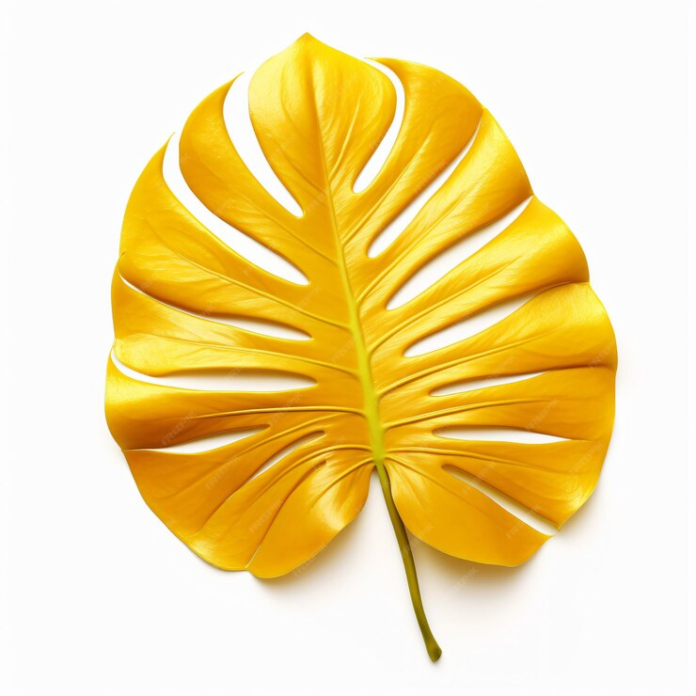Monstera plants, known for their lush, tropical foliage, are a popular choice among indoor plant enthusiasts. However, when the leaves of your Monstera start turning yellow, it can be a cause for concern. In this article, we’ll delve into the reasons behind this common issue and explore effective strategies to restore your Monstera’s vibrant greenery.

Natural Aging Process: A Normal Phenomenon
One of the primary reasons Monstera leaves turn yellow is the natural aging process. As older leaves mature, they naturally change color and eventually turn yellow before dropping off. This is a normal part of the plant’s growth cycle and doesn’t necessarily indicate a problem. Regularly pruning yellowing leaves can help redirect the plant’s energy towards new growth.
Overwatering: Striking a Balance
One of the most common issues leading to yellow Monstera leaves is overwatering. Monstera plants prefer well-draining soil, and excessive moisture can lead to root rot—a condition where the roots suffocate due to lack of oxygen. This impedes the plant’s ability to absorb nutrients, resulting in yellow leaves. Adjusting your watering routine and ensuring proper drainage can prevent this problem.
Root Check: Signs of Overwatering
To determine if overwatering is the culprit, carefully inspect the plant’s roots. Healthy roots are firm and white, while rotting roots are mushy and brown. Trim away any affected roots and repot the Monstera in fresh, well-draining soil. Adjusting your watering schedule to allow the topsoil to dry out between waterings is essential for preventing future overwatering issues.
Underwatering: Finding the Right Balance
On the flip side, underwatering can also cause Monstera leaves to turn yellow. Insufficient water hinders the plant’s ability to conduct essential processes like photosynthesis, leading to a nutrient imbalance and yellowing leaves. Establishing a consistent watering routine, ensuring proper hydration, and adjusting based on environmental conditions are key to preventing underwatering-related issues.
Soil Moisture Assessment
Regularly assess the moisture level in the soil by inserting your finger into the top inch. If it feels dry, it’s time to water; if it’s still moist, wait a bit longer. Consider factors like humidity, temperature, and the size of the pot when establishing a watering schedule. Adjustments may be needed seasonally or as the plant grows.
Nutrient Deficiency: Feeding Your Monstera
Yellowing leaves may be a sign of nutrient deficiency, particularly a lack of essential minerals like nitrogen, magnesium, or iron. Monstera plants thrive in nutrient-rich soil, and when key elements are lacking, it can manifest in yellow leaves. Regularly fertilizing your Monstera with a balanced, water-soluble fertilizer can help maintain optimal nutrient levels.
Fertilization Tips
Choose a fertilizer specifically formulated for tropical plants, and follow the recommended application rates. Over-fertilization can be as harmful as under-fertilization, so it’s crucial to strike the right balance. Fertilize during the growing season (spring and summer) and reduce or withhold fertilizer during the dormant period (fall and winter).
Lighting Conditions: Finding the Sweet Spot
Monstera plants thrive in bright, indirect light. Insufficient light can slow down photosynthesis, leading to yellowing leaves. On the other hand, excessive direct sunlight can scorch the leaves, causing them to turn yellow and develop brown spots. Assess the plant’s current lighting conditions and make adjustments accordingly.
Ideal Lighting for Monstera
Place your Monstera where it receives bright, filtered sunlight. Avoid exposing it to prolonged periods of direct sunlight, especially during the intense midday hours. If your plant is struggling due to inadequate light, consider relocating it to a brighter spot or supplementing with artificial grow lights.
Pests and Diseases: Uninvited Guests
Yellowing leaves can also be a result of pests or diseases affecting your Monstera. Common culprits include spider mites, mealybugs, and fungal infections. Regularly inspect your plant for signs of pests, such as webbing, tiny insects, or unusual spots on the leaves.
Pest Control Measures
If pests are identified, isolate the affected plant to prevent the infestation from spreading. Use insecticidal soap or neem oil to treat pests, and follow a consistent preventive maintenance routine. For fungal issues, ensure proper air circulation and avoid overwatering to minimize the risk of infections.
Conclusion: Restoring Monstera’s Lush Greenery
In conclusion, yellowing leaves on your Monstera can be attributed to various factors, ranging from natural aging to environmental conditions, watering practices, nutrient deficiencies, and pest infestations. Regular monitoring, timely adjustments, and proactive care are essential to ensure your Monstera remains vibrant and healthy. By addressing the specific issues causing yellowing leaves, you can revive your Monstera’s lush green appearance and continue to enjoy the beauty of this tropical houseplant.



